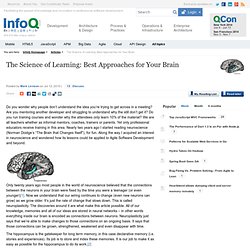

Metacognition And Learning: Strategies For Instructional Design. Do you know how to learn?

Many people don’t. Specifically, they don’t know how to look inward to examine how they learn and to judge which methods are effective. That’s where metacognitive strategies come in. They are techniques that help people become more successful learners. Shouldn’t this be a crucial goal of instructional design? Improved metacognition can facilitate both formal and informal learning. But let’s start at the beginning. What is metacognition? Metacognition is often referred to as “thinking about thinking.”
The Two Processes of Metacognition Many theorists organize the skills of metacognition into two complementary processes that make it easier to understand and remember. Metacognition and Expertise Many experts cannot explain the skills they use to elicit expert performance. Examples of Metacognition Skills You May Use Successful learners typically use metacognitive strategies whenever they learn. Metacognitive Strategies Ask Questions. References: Learning Development and Innovation Publications & Reports.
The Science of Learning: Best Approaches for Your Brain. Do you wonder why people don’t understand the idea you’re trying to get across in a meeting?

Are you mentoring another developer and struggling to understand why the still don’t get it? Do you run training courses and wonder why the attendees only learn 10% of the material? We are all teachers whether as informal mentors, coaches, trainers or parents. Yet only professional educators receive training in this area.
Nearly two years ago I started reading neuroscience (Norman Doidge’s “The Brain that Changes Itself”), for fun. Only twenty years ago most people in the world of neuroscience believed that the connections between the neurons in your brain were fixed by the time you were a teenager (or even younger)[1]. The hippocampus is the gatekeeper for long term memory, in this case declarative memory (i.e. stories and experiences). Abstract Ideas We sometimes start talking about Unit Testing with a long theoretical explanation and we get blank stares from the people we’re trying to help.
50 Brain Facts Every Educator Should Know. January 27th, 2010 By Pamelia Brown The brain is perhaps the most fascinating organ in the human body. It controls everything from breathing to emotions to learning. If you work with children, here are some facts that you might find helpful, from how the brain affects learning to facts about memory to interesting facts about the brain that you can share with your students. Brain Development and Learning Read on to learn interesting facts about how the brain develops, what can affect that development, and how learning is impacted.
Read aloud. Memory Learn about the way short-term memory differs from long-term memory, how scent affects memory, and more. Different types of memory. Brain Trivia From how the brain helps while blinking to early brain surgery, these bits of trivia might come in handy the next time you are teaching about the brain. Blinking. The Physical Brain With this list, you’ll be prepared the next time you need to whip out fast facts about the make-up of the human brain.
Water. Unconscious learning uses old parts of the brain. Public release date: 6-Apr-2010 [ Print | E-mail Share ] [ Close Window ] Contact: Katarina Sternuddkatarina.sternudd@ki.se 46-852-483-895Karolinska Institutet A new study from the Swedish medical university Karolinska Institutet provides evidence that basic human learning systems use areas of the brain that also exist in the most primitive vertebrates, such as certain fish, reptiles and amphibians.

The study involved an investigation into the limbic striatum, one of the evolutionarily oldest parts of the brain, and the ability to learn movements, consciously and unconsciously, through repetition. "Our results strongly substantiate the theories that say that the implicit, by which I mean non-conscious, learning systems of the brain are simpler and evolutionarily older," says Associate Professor Fredrik Ullén from Karolinska Institutet and the Stockholm Brain Institute. Download press images: For further information, contact: [ Print | E-mail AAAS and EurekAlert!